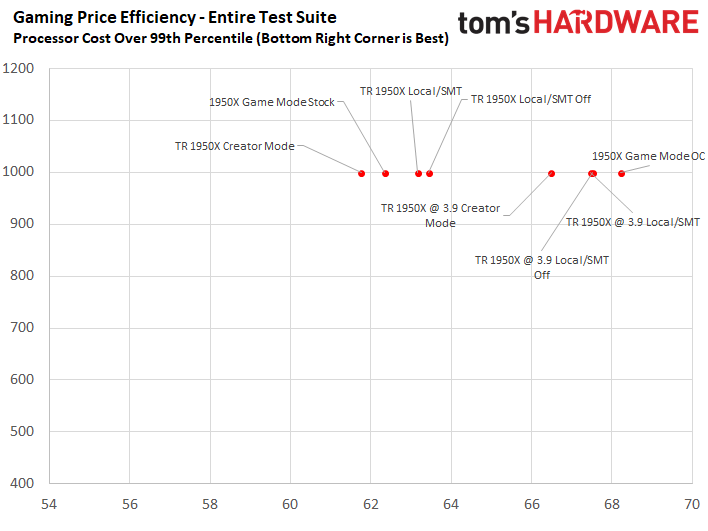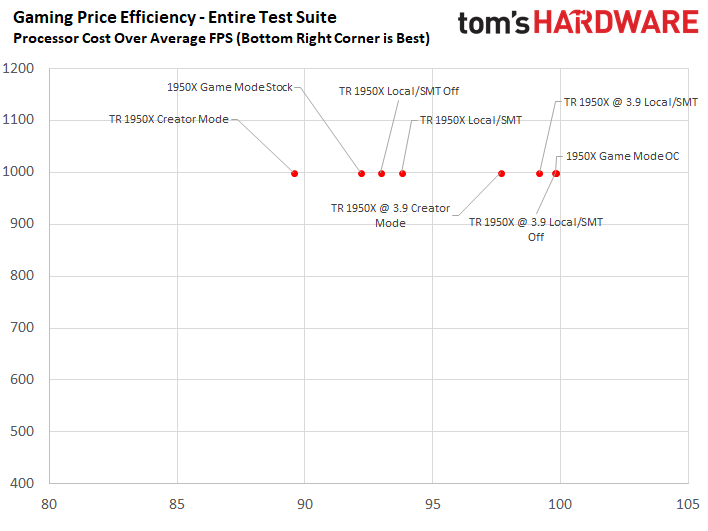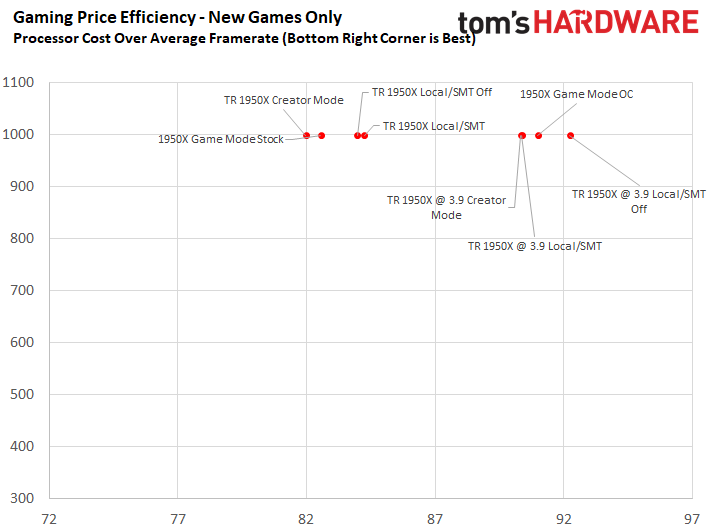AMD Ryzen Threadripper 1950X Game Mode, Benchmarked
Final Analysis
AMD created new settings to help customers optimize the performance of its unique architecture. The options enable capabilities that simply weren't available on the desktop before now. Naturally, it's important to flip those switches and see what happens, particularly given the broad range of workloads that AMD says its Threadripper CPUs excel in.
AMD aims Threadripper at content creators, heavy multitaskers, and gamers who stream simultaneously. It also says the processors are ideal for gaming at high resolutions. Ryzen Threadripper 1950X isn't intended for playing around at low resolutions, particularly in older, lightly-threaded titles. Still, we tested at 1920x1080 to emphasize the difference between the various modes and settings AMD exposes, rather than show you results bound by our graphics card.
We plotted performance with both average frame rates and a geometric mean of the 99th percentile frame times (a good indicator of smoothness), which we convert into an FPS measurement. Our suite includes six games released in 2016 and five older titles that launched in 2014/2015. Threadripper’s extra cores could enable more performance in the future as software evolves to utilize them better, so we also include a chart with newer games that exploit host processing resources more thoroughly.




Looking at the results spread across our entire gaming suite, the difference in performance between modes is surprisingly small. Four frames per second, on average, separate the fastest and slowest settings at stock clock rates. And we see a mere ~2 FPS delta with 99th percentile frame times. Overclocking the processor offers a more significant jump in performance than any mode configuration, and the difference between the various overclocked configurations is also small. We do see slightly larger deltas between the configurations in new titles, but again, they certainly aren't huge. And of course, gaming at higher resolutions does even more to narrow the gaps between settings.
Creator mode exhibits the bipolar gaming performance we've come to expect; it trails by a significant margin in lightly threaded games, but excels in titles that utilize lots of threads and uniform memory access. Unfortunately, some games appear to suffer from the Distributed mode, so leading performance in threaded titles isn't a given. This mode stumbles hard enough during our Civilization VI, Warhammer, Grand Theft Auto V, and Project CARS benchmarks that you'll certainly want to reboot and switch out of it.
Game mode provides solid performance in lightly threaded titles and lower frame rates in more heavily threaded games, but it often gives you a better 99th percentile result, indicating a smoother experience. It is a more reliable default mode, though you'll want to evaluate the experience for yourself on a case-by-case basis.
Switching off SMT and leaving both dies active, as we did with our Local/SMT Off configuration, provides good results, even as it cuts into available host processing resources.
Get Tom's Hardware's best news and in-depth reviews, straight to your inbox.
Using Game mode or disabling SMT doesn't make much sense to us. A big part of Threadripper's allure is its ability to hammer through threaded workloads, even as other tasks are running simultaneously. Switching into Game mode sacrifices threads and cache, giving up performance in those situations.
Beyond recommending against Creator mode for gaming, we can't simply suggest one "best" combination of settings for single- and multi-threaded titles. There is simply too much variance as we expand the breadth of our suite. And that's likely why AMD enabled as many options as it did. Unfortunately, characterizing the behavior of your favorite games and rebooting between sessions probably won't be a popular pastime among enthusiasts.
Compromise might be the best approach. Leaving all threads active and switching to local memory access seems to provide the best of both worlds. This mode attempts to pin memory to the die executing the workload, thus offering a decent performance boost. But it also leaves the 1950X's complement of 32 threads available for heavy processing. Overall, this gives you optimal performance.
Of course, there are a few titles that won't initialize when confronted with 32 threads, so Legacy mode is a requirement in those isolated cases. It will be interesting to see how Intel tackles the same issue when its high-end Skylake-X models land.
Even at its worst, Threadripper delivers adequate performance in a majority of games at 1080p. Most enthusiasts will pair these high-end CPUs with fast graphics cards and high-res monitors though. In that case, Threadripper is easily quick enough to keep up at graphics-bound settings. Having 32 threads at your disposal for heavy lifting in the background is nice, too.
MORE: Best CPUs
MORE: Intel & AMD Processor Hierarchy
MORE: All CPUs Content
Current page: Final Analysis
Prev Page Far Cry Primal, Rise of the Tomb Raider & The Witcher 3: Wild Hunt
Paul Alcorn is the Editor-in-Chief for Tom's Hardware US. He also writes news and reviews on CPUs, storage, and enterprise hardware.
-
beshonk "extra cores could enable more performance in the future as software evolves to utilize them better"Reply
I can't believe we're still saying this in 2017. Developers suck at their job. -
sztepa82 "AMD aims Threadripper at content creators, heavy multitaskers, and gamers who stream simultaneously. It also says the processors are ideal for gaming at high resolutions. Ryzen Threadripper 1950X isn't intended for playing around at low resolutions, particularly in older, lightly-threaded titles. ____Still, we tested at 1920x1080____ ...."Reply
Thank you for being out there for us, Tom's, no other website has ever done that. The only other thing we can hope for is that you'll also do a 2S Epyc 7601 review playing Project Cars in 320x240. -
shrapnel_indie ReplyEach change requires a reboot, chewing up precious time as you save open projects, halt conversations, and try to remember which web browser tabs to relaunch.
not if you're running the right browser with the right options active. Firefox can remember the last tabs you had open and reopen them upon startup... of course this is within the last Firefox window closed, and you have to properly exit. (no killing the thread(s).) -
-Fran- Since this CPU (and Intel's X and XE line) are aimed for big spenders, when are you guys going to test multi GPU in these CPUs?Reply
Also, you mentioned streaming as part of the big CPU charisma, but there was no actual test with it. Why not just run OBS with the same software encoding settings for each platform and run a game? It's not that hard to do, is it?
Cheers! -
Dyseman Quote- 'When I go to pause the video (ad) your site takes me to another tab. Bye, bye.'Reply
It's easy enough to disable the JW Player with ublock. Those videos are not considered ads but adblockers, but you can tell it to block anything that uses JW Player, then whitelist any other site that needs to use it for NON-ADs. -
rhysiam Thanks for this investigation Toms, really thorough and interesting article.Reply
It's interesting and a little disappointing that an OC to 3.9Ghz seems to pretty consistently achieve a small but measurable bump in gaming. The 1950X can use XFR to get to 4.2Ghz on lightly threaded workloads. Obviously in well-threaded games the CPU isn't going to be able to sustain 4.2Ghz, but it's a bit disappointing it can't manage 3.9-4ghz across the 4-6 cores used in gaming workloads. In fact, judging from the results it seems to be sitting around 3.7-3.8Ghz or so in most games. That seems low to me. There should be plenty of thermal and power headroom available to to get 4-6 cores up to nice high clocks, which should be enough cores for pretty much every game in the suite (except perhaps AOTS). If that was happening we'd see the OC making no difference, or even perhaps causing a slight performance regression in games (like it does in synthetic single-threaded tests). But clearly that's not the case.
It seems to me that AMD's power management implementation is resulting in some pretty conservative clock speeds in the 4-6 core workload range. That has implications outside of gaming as well, because 4-6 thread workloads are quite common even in the productivity and content creation space. It's hardly a deal breaker (we're only looking a couple of hundred mhz), but I'm curious whether others think AMD is giving up a little more performance than they should be here? Or am I missing something? -
jdwii Reply20187640 said:Thanks for this investigation Toms, really thorough and interesting article.
It's interesting and a little disappointing that an OC to 3.9Ghz seems to pretty consistently achieve a small but measurable bump in gaming. The 1950X can use XFR to get to 4.2Ghz on lightly threaded workloads. Obviously in well-threaded games the CPU isn't going to be able to sustain 4.2Ghz, but it's a bit disappointing it can't manage 3.9-4ghz across the 4-6 cores used in gaming workloads. In fact, judging from the results it seems to be sitting around 3.7-3.8Ghz or so in most games. That seems low to me. There should be plenty of thermal and power headroom available to to get 4-6 cores up to nice high clocks, which should be enough cores for pretty much every game in the suite (except perhaps AOTS). If that was happening we'd see the OC making no difference, or even perhaps causing a slight performance regression in games (like it does in synthetic single-threaded tests). But clearly that's not the case.
It seems to me that AMD's power management implementation is resulting in some pretty conservative clock speeds in the 4-6 core workload range. That has implications outside of gaming as well, because 4-6 thread workloads are quite common even in the productivity and content creation space. It's hardly a deal breaker (we're only looking a couple of hundred mhz), but I'm curious whether others think AMD is giving up a little more performance than they should be here? Or am I missing something?
Ryzen hits a certain point in return pretty darn fast for example CPU might only use 1.15V to get 3.6ghz stable but 3.9ghz needs like 1.3V way to much. -
papality Reply20185985 said:"extra cores could enable more performance in the future as software evolves to utilize them better"
I can't believe we're still saying this in 2017. Developers suck at their job.
Intel's billions had a lot to say in this.

